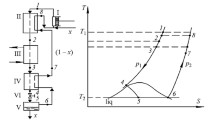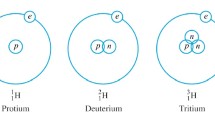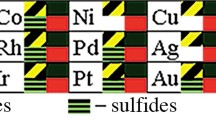Abstract
The Physikalisch-Technische Reichsanstalt in Berlin was also interested in material properties at low temperatures at the time. In 1913 Walther Meissner was commissioned by Emil Warburg, the president of the Reichsanstalt, to build a hydrogen liquefaction plant. Before studying physics, Meissner had already graduated as a mechanical engineer, so he was well prepared for this task.
Access provided by Autonomous University of Puebla. Download chapter PDF
Similar content being viewed by others
The Physikalisch-Technische Reichsanstalt in Berlin was also interested in material properties at low temperatures at the time. In 1913 Walther Meissner was commissioned by Emil Warburg, the president of the Reichsanstalt, to build a hydrogen liquefaction plant. Before studying physics, Meissner had already graduated as a mechanical engineer, so he was well prepared for this task. At the beginning of 1913, he was able to commission an improved liquefier based on a design by Walther Nernst. At that time, Meissner was mainly concerned with electrical resistance measurements at low temperatures.
The outbreak of the First World War in 1914 led to a significant interruption of basic physics research in many countries, including the Berlin Reichsanstalt. Subsequently, in the years 1918–1922, Meissner was particularly concerned with the enlargement of the hydrogen liquefaction plant and, from 1920 onward, increasingly with the possibility of setting up a plant for the liquefaction of helium. His plans and drafts could be realized in the years 1922–1924. On March 7, 1925, helium was liquefied for the first time in the Reichsanstalt. In the process, about 200 cm3 of liquid helium was obtained. The Reichsanstalt was the third place in the world where experiments with liquid helium could be carried out, after Leiden as the first and from 1923 Toronto in Canada as the second place. As members of the Reichsanstalt’s board of trustees, Carl von Linde and Wilhelm Conrad Röntgen had at the time strongly advocated the establishment of a cryogenic laboratory.
It is said that Walther Meissner carried out his measurements with only 0.3 L of liquid helium for 10 years. Before he appeared, five superconducting elements were known: Lead, mercury, tin, thallium and indium. In 1928, Meissner discovered another superconducting element: tantalum with a critical temperature of 4.4 K. During the following 2 years, he discovered superconductivity in thorium, titanium and niobium as well as in a number of compounds and alloys.
During his term of office from 1922 to 1924 as president of the Reichsanstalt, Walther Nernst, who was known for his farsightedness, had realized that the experimental physicists of the Reichsanstalt could well use the support of a theorist. Nernst was able to enlist the help of Max von Laue, who took up his post as theoretical physicist at the Reichsanstalt on March 24, 1925 (one day a week in addition to his teaching activities at the University of Berlin). At that time, von Laue was interested in superconductivity and especially in its magnetic properties. He maintained close contact with Walther Meissner and in 1933 persuaded him to take precise measurements of an applied magnetic field near the surface of a superconductor at the transition from normal conduction to superconductivity. Von Laue was also able to help finance an additional employee for these experiments from a support program for unemployed young scientists at the time.
This is how Walther Meissner and his colleague Robert Ochsenfeld made a highly momentous discovery in 1933: In the superconducting state, a magnetic field inside the superconductor disappears by being forced out of it. Since then, this phenomenon has been known as the Meissner-Ochsenfeld effect (often abbreviated to Meissner effect) (Fig. 2.1). Thus, a superconductor (below the critical magnetic field HC(T)) behaves like a perfect diamagnet.
Meissner-Ochsenfeld effect. a In the normal state above its critical temperature, the spherical superconductor is permeated by the external magnetic field. b Below the critical temperature, the superconductor expells the magnetic field completely from its interior as long as the critical magnetic field is not exceeded. The field expulsion is caused by electric currents that flow around the surface of the superconductor without loss and shield the interior of the superconductor from the magnetic field
The existence of the Meissner-Ochsenfeld effect allows an important conclusion: The superconducting state is a thermodynamic equilibrium state. Thus, the state is independent of the path that led to it. If the magnetic field and/or the temperature changes, in the end only the following must apply: \({\text{T}} < {\text{T}}_{{\text{C}}}\) and \({\text{H}} < {\text{H}}_{{\text{C}}} \left( {\text{T}} \right)\).
Cornelis Jacobus Gorter and Hendrik Brugt Gerhard Casimir were the first to recognize this fundamental importance of the Meissner-Ochsenfeld effect in 1934. Their conclusion is explained in Fig. 2.2. The point c marks the superconducting state below the critical temperature TC and the critical magnetic field HC(T). Infinite electrical conductivity without existence of the Meissner-Ochsenfeld effect on the path a → b → c would result in the state with \({\text{B}} = 0\), while the path a → d → c would result in the state with B ≠ 0 of point d. Only the existence of the Meissner-Ochsenfeld effect ensures that the state with \({\text{B}} = 0\) (perfect diamagnetism) is always reached (independent of the path covered). However, it is assumed that the superconductor shows perfect reversibility and that no pinning forces hold the magnetic flux inside the superconductor. Max von Laue later called the discovery of the Meissner-Ochsenfeld effect a turning point in the history of superconductivity.
Based on the Meissner-Ochsenfeld effect, the energy difference between the normal (nonsuperconducting) and the superconducting state can also be calculated precisely, as Gorter and Casimir were also the first to recognize. We will briefly explain their train of thought. In the presence of a magnetic field H, the density Gs of free Gibbs energy in the superconducting state is
Here M(H) is the magnetization. In the case of perfect diamagnetism due to the Meissner-Ochsenfeld effect
\(\int_{0}^{{\text{H}}} {{\text{M}}\left( {\text{H}} \right)\;{\text{dH}}}\) in Eq. (2.1) contains the work done in expelling the magnetic field. Together with Eq. (2.2), this results in
In equilibrium, however, the following applies to the case \({\text{H}} = {\text{H}}_{{\text{C}}} \left( {\text{T}} \right):{\text{ G}}_{{\text{n}}} \left( {{\text{T}},{\text{H}}_{{\text{C}}} } \right) = {\text{G}}_{{\text{s}}} \left( {{\text{T}},{\text{H}}_{{\text{C}}} } \right)\) and \({\text{G}}_{{\text{n}}} \left( {{\text{T}},{\text{H}}_{{\text{C}}} } \right) = {\text{G}}_{{\text{n}}} \left( {{\text{T}},0} \right)\). The difference between the energy density in the normal (Gn) and superconducting state is therefore in the case \({\text{H}} = {\text{H}}_{{\text{C}}}\)
For a typical value of the critical magnetic flux density \({\text{B}}_{{\text{C}}} = 10^{ - 2}\) T, the difference in energy density is 398 erg/cm3 = 2.49 · 1014 eV/cm3. It is this very small value of the energy difference in the range of only a few meV per electron that has long delayed the theoretical explanation of superconductivity.
The expulsion of the magnetic field in the Meissner-Ochsenfeld effect is caused by electrical shielding currents flowing along the surface of the superconductor. They generate a magnetic field that is exactly opposite to the original magnetic field and compensates it exactly. In order for this state to persist for any length of time, these “shielding currents” must flow without electrical resistance. Superconductivity is therefore necessary (In normal, nonsuperconducting metals, only the so-called electromagnetic skin effect remains).
We recognize the special significance of the Meissner-Ochsenfeld effect from the fact that the loss-free flowing shielding currents require the phenomenon of superconductivity as a necessary consequence. However, the reverse conclusion that the existence of the Meissner-Ochsenfeld effect follows from the disappearance of the electrical resistance is not admissible. Therefore, the Meissner-Ochsenfeld effect is the decisive “fingerprint” for superconductivity.
Author information
Authors and Affiliations
Corresponding author
Rights and permissions
Copyright information
© 2021 Springer Fachmedien Wiesbaden GmbH, part of Springer Nature
About this chapter
Cite this chapter
Huebener, R.P. (2021). Walther Meissner and the Physikalisch-Technische Reichsanstalt in Berlin. In: History and Theory of Superconductors. essentials(). Springer, Wiesbaden. https://doi.org/10.1007/978-3-658-32380-6_2
Download citation
DOI: https://doi.org/10.1007/978-3-658-32380-6_2
Published:
Publisher Name: Springer, Wiesbaden
Print ISBN: 978-3-658-32379-0
Online ISBN: 978-3-658-32380-6
eBook Packages: Physics and AstronomyPhysics and Astronomy (R0)






